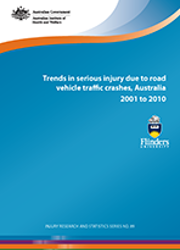Summary
This report presents estimates of trends in the number and rate of persons seriously injured in Australia due to road vehicle traffic crashes. Serious injury is defined as cases where a person was admitted to hospital for an injury and was discharged alive. Cases involving types of injury that are life-threatening are the main focus. Deaths are not included.
Trends in serious injury
Over the 10-year period from 2001 to 2010, age-standardised rates for people seriously injured due to a road vehicle traffic crash fluctuated but increased overall, from 141.6 to 146.4 per 100,000 population, an average annual increase of 0.9%.
All jurisdictions except for Victoria, South Australia and Tasmania showed increases in age-standardised rates of serious injury due to road vehicle traffic crashes over the 10-year period. Victoria was the only jurisdiction to record a statistically significant decrease.
Trends in life-threatening injury
Over one-quarter (26%) of those seriously injured due to road vehicle traffic crashes over the 10-year period from 2001 to 2010 sustained life-threatening injuries.
The highest rates were for people aged 15-24 years, for both males and females. The largest increase over the 10-year period was for males aged 45-64 years.
Rates of life-threatening cases involving motorcycle riders and pedal cycle riders rose significantly over this period, with average annual increases of 5.2% and 7.5% respectively. Rates of cases involving passengers of motor vehicles and pedestrians fell, with average annual decreases of 1.2% and 1.0% respectively.
For males injured as motorcycle riders, rates in all age groups, except those aged 0-4 years and 15-24 years, increased over the 10-year period. The largest average annual increases in rates were recorded in the age groups 45-64 years and 65 years and over, with average annual increases of 13.2% and 14% respectively. For females injured as motorcyclists, increases occurred for those aged 14-24 years, 25-44 years and 45-64 years.
Injuries per registered motorcycle did not change much from 2001 to 2010, suggesting that the rise in population-based rates is largely due to growth in the number of motorcycles in use.
Rates also rose for males and females injured as pedal cycle riders, in age groups 25-44 years and 45-64 years, as well as for males aged 65 years and over. The largest average annual increase in rates for males and females was recorded for those aged 45-64 years, with average annual increases of 14.1% for males and 15.7% for females.
The overall rise for males aged 45-64 years is accounted for by the rise in injuries sustained as a motorcyclist or pedal cyclist. In 2001, 31% of all high-threat-to-life road injuries sustained by males aged 45-64 years occurred while they were riding motorcycles or pedal cycles. This proportion rose to over 58% in 2010.
Increases in life-threatening road injury were greater for people living in remote areas (average annual increase of 3.7%) than for those living in Major cities and Outer regional areas.



